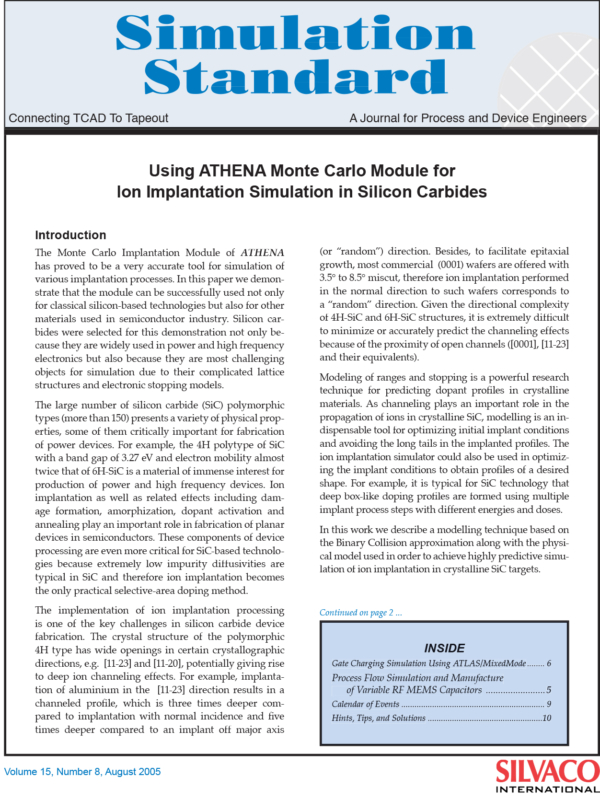Using Athena Monte Carlo Module for Ion Implantation Simulation in Silicon Carbides
Introduction
The Monte Carlo Implantation Module of ATHENA has proved to be a very accurate tool for simulation of various implantation processes. In this paper we demonstrate that the module can be successfully used not only for classical silicon-based technologies but also for other materials used in semiconductor industry. Silicon carbides were selected for this demonstration not only because they are widely used in power and high frequency electronics but also because they are most challenging objects for simulation due to their complicated lattice structures and electronic stopping models.
The large number of silicon carbide (SiC) polymorphic types (more than 150) presents a variety of physical properties, some of them critically important for fabrication of power devices. For example, the 4H polytype of SiC with a band gap of 3.27 eV and electron mobility almost twice that of 6H-SiC is a material of immense interest for production of power and high frequency devices. Ion implantation as well as related effects including damage formation, amorphization, dopant activation and annealing play an important role in fabrication of planar devices in semiconductors. These components of device processing are even more critical for SiC-based technologies because extremely low impurity diffusivities are typical in SiC and therefore ion implantation becomes the only practical selective-area doping method.
The implementation of ion implantation processing is one of the key challenges in silicon carbide device fabrication. The crystal structure of the polymorphic 4H type has wide openings in certain crystallographic directions, e.g. [11-23] and [11-20], potentially giving rise to deep ion channeling effects. For example, implantation of aluminium in the [11-23] direction results in a channeled profile, which is three times deeper compared to implantation with normal incidence and five times deeper compared to an implant off major axis (or “random”) direction. Besides, to facilitate epitaxial growth, most commercial (0001) wafers are offered with 3.5° to 8.5° miscut, therefore ion implantation performed in the normal direction to such wafers corresponds to a “random” direction. Given the directional complexity of 4H-SiC and 6H-SiC structures, it is extremely difficult to minimize or accurately predict the channeling effects because of the proximity of open channels ([0001], [11-23] and their equivalents).
Modeling of ranges and stopping is a powerful research technique for predicting dopant profiles in crystalline materials. As channeling plays an important role in the propagation of ions in crystalline SiC, modelling is an indispensable tool for optimizing initial implant conditions and avoiding the long tails in the implanted profiles. The ion implantation simulator could also be used in optimizing the implant conditions to obtain profiles of a desired shape. For example, it is typical for SiC technology that deep box-like doping profiles are formed using multiple implant process steps with different energies and doses.



